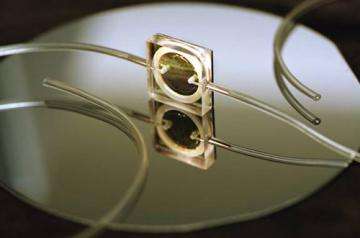Nanolaser Device Detects Cancer in Single Cells

Using an ultrafast, nanoscale semiconductor laser, investigators at Sandia National Laboratories in New Mexico, have discovered a way of rapidly distinguishing between malignant and normal cells. Moreover, this new technique has the potential of detecting cancer at a very early stage, a development that could change profoundly the way cancer is diagnosed and treated.
Reporting its work in the journal Biomedical Microdevices, a team of researchers led by Paul Gourley, Ph.D., described the methods it used to construct a device that can flow cells one at a time past an ultrafast laser, and how this device revealed that malignant cells have a characteristic optical response that differs from that of a normal cell. This response, the researchers found, arises from the fact that mitochondria, the internal organelles that produce a cell’s energy, are scattered in a chaotic, unorganized manner in malignant cells, while they form organized networks in healthy cells. This difference produces a marked change in the way that malignant cells scatter laser light.
The researchers were then able to show that they could measure this change when flowing individual cells through a “biocavity laser” that Gourley’s group had previously developed. The change shows up as a difference in the fluorescent signal they observed at two different frequencies of light. The investigators note that they are now studying other cellular components to determine if these intracellular structures also have laser-detectable differences between malignant and normal cells.
This work is detailed in a paper titled, “Ultrafast nanolaser flow device for detecting cancer in single cells.” An investigator from the University of California, San Diego, also participated in this study.
An abstract is available through PubMed.
Source: National Cancer Institute















